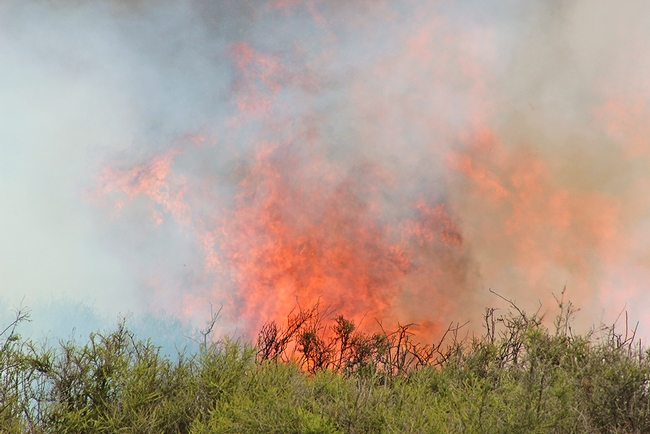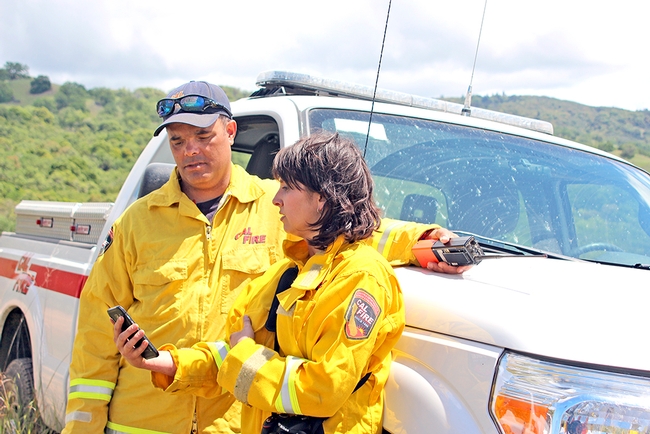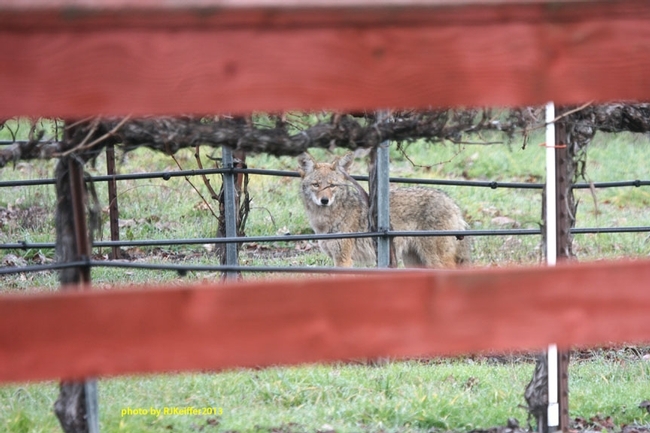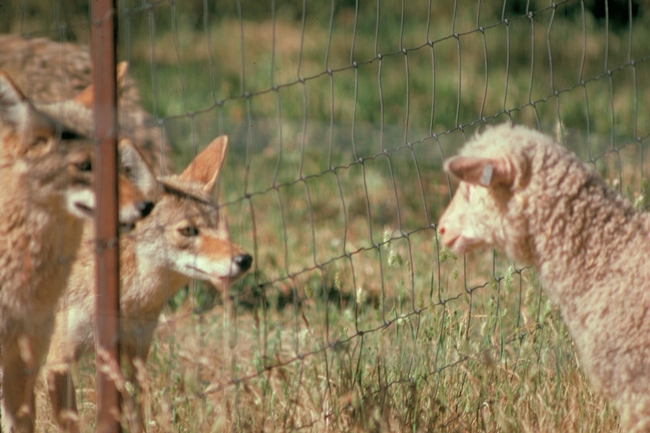Posts Tagged: Kim Rodrigues
Fire devoured chaparral plots at UC facility to set up a research project
The prescribed burn was carefully orchestrated by CalFire. Wide swaths of vegetation had been cleared around the 7-acre and 9-acre study areas and the weather carefully monitored before a truck-mounted “terra torch” sent streams of flammable gel into the brush, igniting a raging fire.
The fires at Hopland set up a study for a UC Berkeley doctoral student researching post-fire nitrogen cycling, provided a training ground for new CalFire recruits who will be battling blazes in the summer, and launched a new partnership between HREC and CalFire.
Chaparral shrublands, which cover about 7 percent of California natural lands, are vital California ecosystems. Chaparral contains 25 percent of the state's endemic plant and animal diversity. Nature and Native Americans burned chaparral at regular intervals for millennia, providing fresh new growth for foraging animals.
“After a chaparral fire, you typically get a flush of ephemeral wildflowers, some of which are very rare, which you haven't seen for 30 years or since the last fire,” said Lindsey Hendricks-Franco, a doctoral student at UC Berkeley who is conducting research at Hopland. “The amazing thing about these plants is their seeds can survive in the seedbank for decades. Then heat or smoke or an open canopy can stimulate them to germinate. It can be beautiful.”
The most abundant plant in Hopland chaparral, chamise, is barely fazed by fire. The plant's underground burl will soon sprout after a fire, and chamise seeds readily germinate in ash-enriched soil.
To understand the role of nitrogen cycling in the post-fire chaparral ecosystem, Hendricks-Franco and her research staff clambered over dense brush before the fire to collect soil samples and place ingenious heat sensors that document the burn temperature. After the fire, she returned to each site to collect post-treatment soil samples and heat sensors.
“It's a challenge to put sensors in a fire this hot. Most heat sensors are destroyed by the intense heat,” Hendricks-Franco said. “I painted four- by four-inch tiles with a variety of heat-sensitive paints. The paints change color at different temperatures. When I collect the tiles, they will give me an idea about the temperatures reached in the fire.”
The controlled burn at Hopland was the first step in rebuilding a partnership with CalFire, said Kim Rodrigues, who has served as the facility's director since 2014. The areas burned in April were previously burned by CalFire for fire research in the 1990s.
“We've been here since 1951 offering applied and relevant research,” Rodrigues said. “It's primarily research on ecosystem management in oak woodlands, grassland and chaparral. Fire on the landscape is a management tool.”
The 5,800-acre research facility is one of nine such centers managed by UC Agriculture and Natural Resources in a variety of California ecosystems, from high desert near the Oregon border, low desert in the Imperial Valley, Sierra Nevada forests and San Joaquin Valley farmland. Hopland is also home to 500 sheep.
Hopland CalFire battalion chief Michael Maynard was the incident commander at the April controlled burns, which he said also fulfilled CalFire objectives.
“It's good to be back here to join up with the University of California,” Maynard said. “The fire falls into our realm of training and expertise and we're helping their realm of expertise, which is research. There are 10 plots on this specific research project, so we'll be back soon.”
Maynard brought in newly hired firefighters for training on setting and controlling a prescribed burn.
“It's important that we brush up on our skills. We have seasonal employees that have hired on early and are participating. So the all-around training value is incredible and pays off later in the summer,” Maynard said.
CalFire will be back at Hopland in the fall to implement another chaparral burn so Hendricks-Franco can compare the fate of nitrogen in areas that burn before the hot, dry summer season to areas that burn in the fall and are followed by rain.
View scenes from the controlled burn in the video below:
Mendocino County no longer to contract with USDA Wildlife Services
Mendocino County supervisors decided to sever ties with the USDA's division of Wildlife Services, reported Peter Fimrite in the San Francisco Chronicle. The decision was made after environmental groups said the agency was indiscriminately killing predators, such as mountain lions and coyotes, because they are a threat to livestock.
The article featured a gallery of 10 artful photos taken at the UC Hopland Research and Extension Center, which maintains a research sheep flock of 500 breeding ewes. Record-keeping of sheep losses to predators began at Hopland in 1973. Coyotes are the most serious predator problem.
Hopland staff use a variety of non-lethal and preventative methods to protect sheep from predators, such as fencing, mob grazing and frequent pasture rotation and guard dogs, according to Kim Rodrigues, the director of the research and extension facility. Currently there are five guard dogs at the center. The guard dogs bond with sheep and protect them primarily by barking and other aggressive behaviors when strangers or predators are near the sheep flock.
Non-lethal predator wildlife control helps keep livestock safe
Five guard dogs are part of the team protecting sheep at a UC Agriculture and Natural Resources (UC ANR) research center in Mendocino County. The director of the UC Hopland Research and Extension Center (HREC) Kim Rodriguez is optimistic the dogs and other non-lethal wildlife control efforts being used at the station will allow peaceful grazing animals to share land with natural predators, reported Sarah Reith in the Ukiah Daily Journal.
Rodrigues initiated a new standard operating procedure (SOP) at Hopland early this year for predator animal control. The policy involves guard dogs, improved fencing and pasture management to protect sheep from coyotes, rather than shooting the predators. Jim Lewers, senior animal technician at HREC, said the "losses have declined" since the new policy was put in place.
Hannah Bird, HREC community educator, said 10 sheep at the center were killed by coyotes in 2015, while 43 were killed in 2014.
Rodrigues told the reporter that it is hard to attribute declines in animal deaths to a single strategy. She hopes to eventually make Hopland a hub for research and information sharing with local landowners on wildlife control.
That effort begins next week. On Dec. 1 and 2, HREC will offer two separate workshops on wildlife management. The first day will include representatives from USDA Wildlife Services, the California Dept. of Fish and Wildlife, and Defenders of Wildlife. On the second day, local ranchers and UC ANR representatives will speak about their chosen methods of wildlife management. Registration is $30 per day. Registration for the two days is separate, and the deadline is Saturday, Nov. 28.
Click here to register for the Dec. 1 workshop.
Click here to register for the Dec. 2 workshop.
Living with wildlife while managing working landscapes
The UC Hopland Research and Extension Center (UC HREC) will host workshops on Dec. 1 and 2 to foster understanding and encourage community dialog about ranching on a landscape with populations of coyote, black bear, mountain lions and other wildlife.
“Mendocino County supports many ranchers and our communities enjoy locally produced lamb, beef, milk, cheese and other agricultural products,” said Kimberley Rodrigues, director of UC HREC. “Along with these opportunities come challenges associated with living alongside some of our resident wildlife. The workshops will help local residents deal with these challenges.”
Rodrigues – who has a doctorate degree in environmental science and has been a leader in outreach, strategic facilitation and partnership development for 25 years – has been actively involved in wildlife management at the 5,300-acre HREC since she arrived in mid-2014.
“I quickly realized the biggest challenge to maintaining a sustainable flock of sheep here in our location is addressing predation issues, primarily by coyotes,” Rodrigues said. “With some improvements to our fences, changes in pasture rotations and increased use of guard dogs, losses of sheep to coyotes are now at an acceptable level. We hope to share our own experience, hear from diverse perspectives and experiences at these events and would like HREC to become a hub for future learning on this topic.”
Recent discussion and decisions made by the Mendocino County Board of Supervisors regarding their contract with USDA Wildlife Services (WS) and their use of an integrated wildlife damage management program prompted UC HREC to provide a space for two workshops to allow learning on wildlife management and community conversation.
The Dec. 1 workshop will focus on scientific design and is implemented by USDA WS. It provides an opportunity to hear experts from USDA, the Californi Department of Fish and Wildlife, UC Cooperative Extension and Defenders of Wildlife to discuss the most up-to-date research in wildlife behavior and non-lethal control methods.
The Dec. 2 community conversation workshop is hosted by UC HREC and includes current research from UC Agriculture and Natural Resources, wildlife biologists and discussion of the challenges associated with ranching in Mendocino County from the Magruder family and other local ranchers. The day will culminate in discussion groups on topics ranging from integrated wildlife management tools to understanding local, state and federal connections.
The public may attend either day or both days. Registration for the two workshops is separate.
“Topography, surrounding environments, community viewpoints, available funds and the kind of animals being farmed are all part of the picture – there is no easy solution,” said Hannah Bird, UC HREC community educator. “Ranchers and land managers need to know what tools are available to them and the implications and benefits of each of these tools. Attending both workshops will provide a deeper understanding of the issues.”
Community members, ranchers, land managers and members of non-profit organizations are invited to attend. The workshops will be at the Rod Shippey Hall, Hopland Research and Extension Center, 4070 University Road, Hopland, CA 95449. Registration is $30 for each day (including lunch) and must be made in advance. The registration deadline is Nov. 23. Space is limited.
Sign up for the Dec. 1 USDA WS workshop at http://ow.ly/TYhBd and the Dec. 2 community conversation workshop at http://ow.ly/TYhos.
More on the University of California Hopland Research and Extension Center:
The Hopland Research and Extension Center is a multi-disciplinary research and education facility run by the University of California, Agriculture and Natural Resources Division. As stewards of more than 5,300 acres of oak woodland, grassland, chaparral, and riparian environments their mission is to find better ways to manage our natural resources and conduct sustainable agricultural practices, through science, for the benefit of California's citizens.
Author: Hannah Bird






